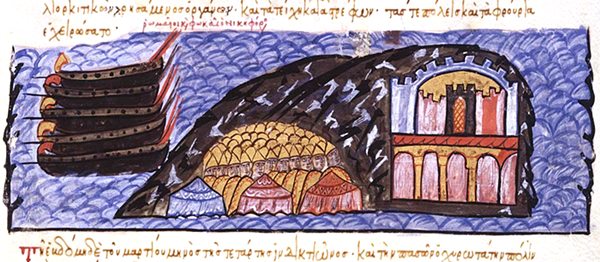
Reconquest of Crete(Battle of Chandax) |
year: 961July 960 - 7 March 961 |
| Nikephoros Phokas recaptured Crete for Byzantium | ★ ★ ★ ★ ★ |
|
enemy: Arabs (of Crete)
|
location: Island of Crete
|
accuracy:
●●●●●
|
|
battle type: Invasion |
war: Later Byzantine-Muslim Wars |
modern country:
Greece |
| ▼ The Byzantines(emperor: Romanos II) | ▼ The Enemies | |
| Commander: | General Nikephoros Phokas | Emir Abd al-Aziz ibn Shuayb |
| Forces: | 700 ships, 77,000 men | Unknown |
| Losses: | Over 200,000 dead |
| Background story: |
| The island of Crete was captured by Andalusian Arabs in 824 and was transformed into an Arab emirate and the base of Muslim pirates that ravaged the Byzantine shores. Piracy practiced by the Cretan Saracens peaked in the 930s and 940s, devastating southern Greece and the western coasts of Asia Minor. Emperor Constantine VII sent an expedition in 949. This too, as in previous efforts, was routed in a surprise attack, a defeat which was ascribed to the incompetence and inexperience of its leader, the eunuch chamberlain Constantine Gongyles. Emperor Constantine did not give up, and during the last years of his reign began preparing another expedition. In the event, it would be carried out under his successor, Romanos II, who entrusted its leadership to the capable general Nikephoros Phokas. |
The Battle: |
 The siege of Chandax in the Skylitzes manuscript The city was pillaged, and its mosques and walls were torn down. The inhabitants either killed or carried off into slavery, while the island's last emir, Abd al-Aziz ibn Shuayb (Kouroupas), and his son al-Numan (Anemas) were taken captive and brought to Constantinople. Phokas was denied the usual honor of a triumph, receiving only a mere ovation in the Hippodrome. The son of the last emir, Al-Numan ibn Abd al-Aziz, or Anemas in Greek sources, became a Christian and served in the Byzantine army, falling at the Battle of Dorostolon in 971. |
Noteworthy: |
| Before the campaign, Romanos had established good relations with the Saracens. According to a source, in the winter of 960, under the pretext that there was a shortage of food in Byzantium, he sent 500 pregnant mares to graze in Crete, with the agreement that half of the foals that would be born would be taken by the Saracens. So when Phokas' army arrived, most of the cavalry had only a saddle and a whip with them, but they found 500 mares to ride. |
Aftermath: |
| The impact of the victory was great in both Byzantium and the Arab world. In Crete, all the mosques were demolished as well as the walls of Chandax. This was followed by an intensive and violent effort to Christianize the population. Phokas built inland the fortress “Temenos” which he tried - unsuccessfully - to establish as a new capital. Crete remained in Greek hands until 1205 (4th Crusade). |
|
|
